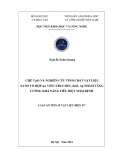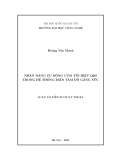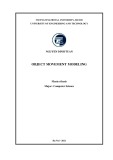
Contents iv
2.4.2 Supervised Learning . . . . . . . . . . . . . . . . . . . . . . . 14
2.4.3 Unsupervised Learning . . . . . . . . . . . . . . . . . . . . . . 18
2.4.4 Semi-supervised Learning . . . . . . . . . . . . . . . . . . . . 19
2.5 Deep Learning .............................. 21
2.5.1 Deep Learning Overview . . . . . . . . . . . . . . . . . . . . . 21
2.5.2 Types of Neural Networks . . . . . . . . . . . . . . . . . . . . 21
2.5.3 Application of deep learning on Computer vision ........ 25
2.5.3.1 Classifications . . . . . . . . . . . . . . . . . . . . . 25
2.5.3.2 Object Detection . . . . . . . . . . . . . . . . . . . . 26
2.5.3.3 Segmentation . . . . . . . . . . . . . . . . . . . . . 27
2.5.4 Application of Deep Learning to analyse porous materials . . . 29
3 Data Acquisition 30
3.1 Introduction ................................ 30
3.2 Data Collection .............................. 30
3.3 Bread dough baking process . . . . . . . . . . . . . . . . . . . . . . . 31
3.4 Reconstruction Micro-CT images . . . . . . . . . . . . . . . . . . . . . 32
3.5 Representative elementary volume (REV) analysis ........... 36
3.6 Preparation of testing datasets . . . . . . . . . . . . . . . . . . . . . . 37
3.6.1 Analysis of testing datasets . . . . . . . . . . . . . . . . . . . . 40
3.7 Generating synthetic training data . . . . . . . . . . . . . . . . . . . . 40
4 Segmentation of Porous Bread dough 45
4.1 Introduction ................................ 45
4.2 Segmentation based on Threshold . . . . . . . . . . . . . . . . . . . . 45
4.3 Segmentation based on U Net . . . . . . . . . . . . . . . . . . . . . . . 47
4.3.1 Model Architecture . . . . . . . . . . . . . . . . . . . . . . . . 47
4.3.2 Model Training .......................... 47
4.4 Results and Discussion .......................... 48
4.4.1 Comparison of U-net and Otsu segmentation .......... 48
5 Extracting Structural Information 51
5.1 Introduction ................................ 51
5.2 Qualitative Metrics ............................ 51
5.3 Snow Algorithm .............................. 52
5.4 Results ................................... 52
6 Conclusion and future work 55
6.1 Conclusion ................................ 55
6.2 Future work ................................ 57
Bibliography 58
Appendix 64































